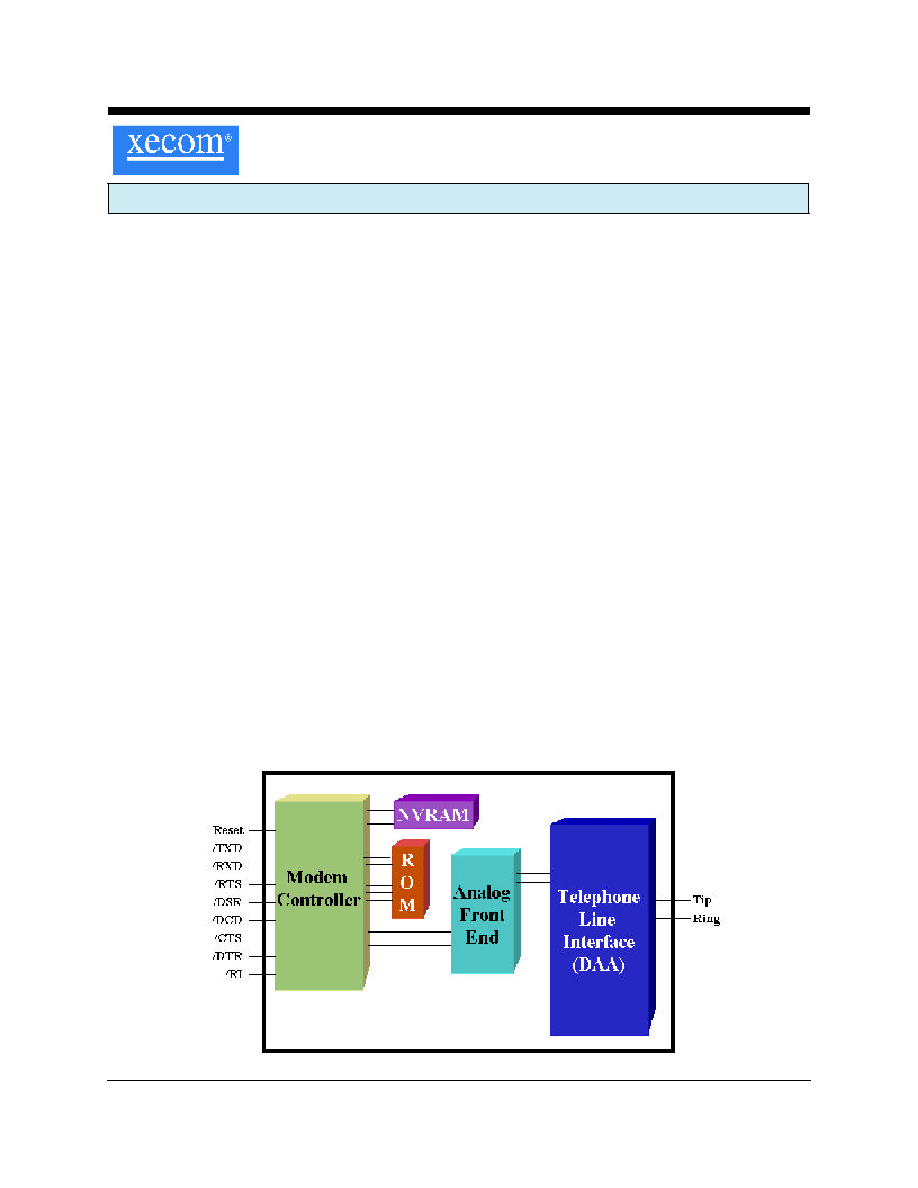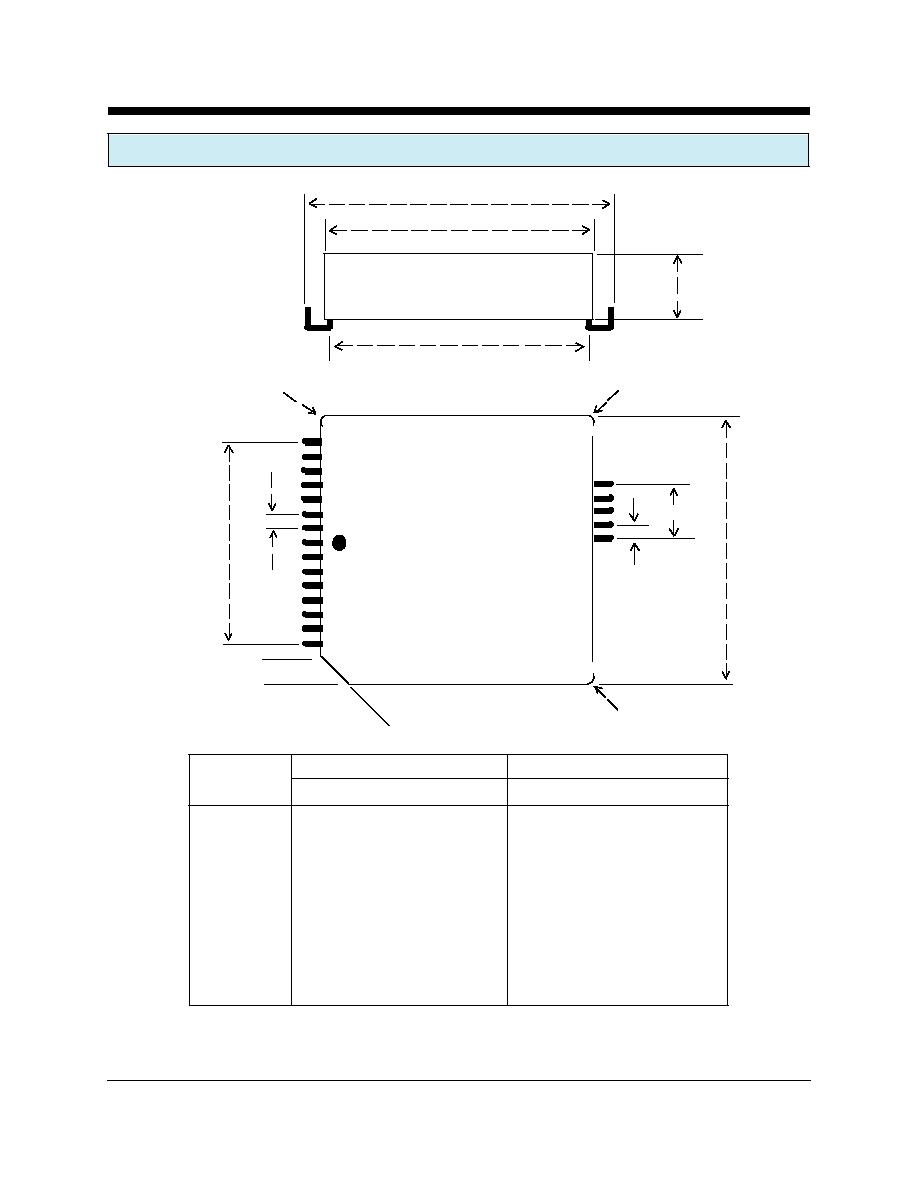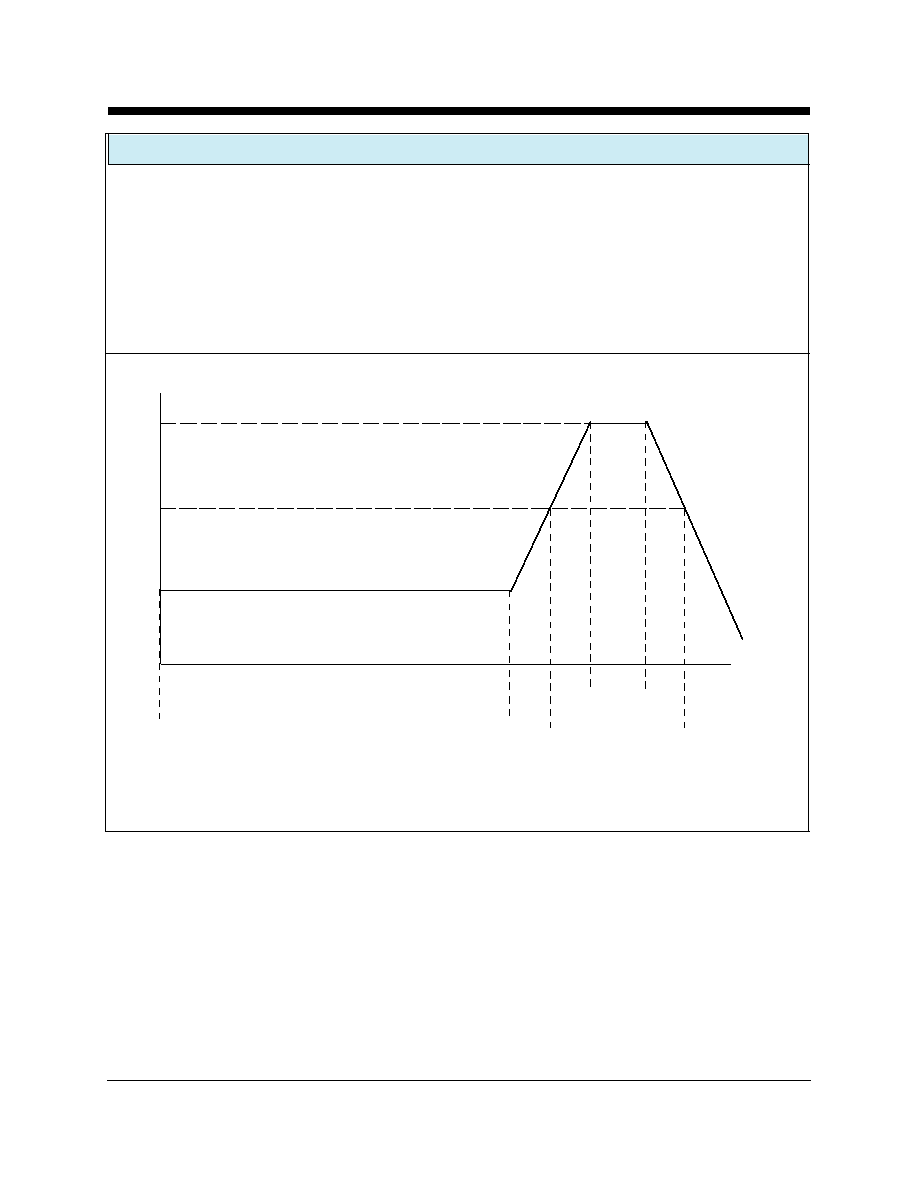
XECOM
(1)
XE5620
XE5620
August 2003
56 KBPS Surface-Mountable Integrated Sealed-Hybrid Modem
Description
Xecom's XE5620 provides a complete 56 KBPS
modem into an miniature, surface-mount package.
Xecom's new HyPLCCTM package (Hybrid PLCC)
makes it possible to meet the conflicting goals of
small size, low cost and surface-mountability. The
XE5620 targets remote monitoring applications in
industrial, commercial and residential locations
As a complete modem, the XE5620 includes not only
all modem circuitry but also user transferrable FCC
Part 68 Registration and UL60950 recognition. This
allows the XE5620 to be easily integrated into your
embedded application.
Xecom's new HyPLCCTM package infuses the XE5620
with both its small size and surface mountability. The
HyPLCC package allows complex hybrid circuits to fit
the 68-Pin PLCC footprint. The HyPLCCTM package
provides a completely sealed environment protecting
the XE5620 during assembly and board cleaning
operations. Xecom also provides a low speed model,
the XE2420, in the HyPLCCTM package.
Features
* Small Size: The HyPLCCTM measures less than 1
inch by 1 inch square and 0.290 inches thick
* Surface-mountable: The HyPLCCTM package is
equivalent to a 68-Pin PLCC device.
* Data transfer at all rates from 300 BPS to 56KBPS
using V.90, V.34bis, V.34, V.32bis, V.32, V.22bis,
V.22, V.23, V.21, Bell 212A, and Bell 103 Protocols
* Supports V.42 error correction and V.42bis Data
Compression
* Modem Control and Configuration via industry
standard AT Commands.
* Non-volatile memory stores modem configuration
and permits stored number dialing.
* Incorporates Fax send and receive capabilities
controlled by Class 1 Fax commands.
* Complete integrated DAA includes, Ring Detect,
Loop Current Holding Circuit, Hook Switch.
Metallic Surge Protection, and Solid-State DAA
* User Transferrable FCC Part 68 Registration
* UL60950 Recognition
* Low Power operation, 3.3 Volts, 300 milliwatt;
XE5620 BLOCK DIAGRAM

XECOM
(2)
XE5620
XE5620 Mechanical Specifications
a
b
c
d
c
f
g
e
e
45
O
i
(TOP)
Inches
Millimeters
Dimension
Min
Typ
Max
Min
Typ
Max
a
0.280
0.285
0.290
7.11
7.24
7.37
b
0.985
0.990
0.995
25.02
25.15
25.27
c
0.950
0.955
0.960
24.13
24.26
24.38
d
0.910
0.920
0.930
23.11
23.37
23.62
e
0.045
0.050
0.055
1.15
1.27
1.40
f
0.695
0.700
0.705
17.65
17.78
17.91
g
0.195
0.200
0.205
10.03
10.16
10.29
i(radius)
0.015
0.020
0.025
0.13
0.25
0.38
i
i
.050"

XECOM
(3)
XE5620
XE5620 Pin Configuration
Pin Descriptions
PIN NAME
DESCRIPTION
1
/DCD
/DCD is an active low output from the modem. The AT&C command controls when the
XE5620 asserts /DCD.
2
/CTS
/CTS is an active low output from the modem. The modem asserts /CTS to indicate that it can
accept data from the terminal equipment on /TXD.
3
/RESET
RESET is an active low input which initiates a modem hardware reset. RESET must be active for
a minimum of 100 milliseconds for a proper modem reset sequence. No external reset is required;
if none is used the RESET signal should be left open.
4
/DSR
/DSR is an active low output from the modem. The AT&S command controls when the XE5620
asserts /DSR.
5
/RTS
/RTS is an active low input to the modem. /RTS indicates to the modem that the host has data
to send.
6
/DTR
/DTR is an active low input to the modem. The AT&D command determines how the modem
will interpret activity on /DTR.
7
/RXD
/RXD provides the path for received data and modem responses to be sent from the modem to
the host terminal equipment.
/DCD
1
/CTS
2
/RESET
3
/DSR
4
24
RING
/RTS
5
23
N/C
/DTR
6
22
TIP
/RXD
7
21
N/C
/TXD
8
20
N/C
/RI
9
19
NP
GND
10
18
NP
SPKR
11
17
NP
N/C
12
16
NP
N/C
13
Vcc
14
N/C
15
TOP

XECOM
(4)
XE5620
8
/TXD
/TXD provides the path for transmitted data and modem commands to be passed from the host
terminal equipment to the modem.
9
/RI
The /RI signal reports on the presence of an incoming ring signal. When a ring occurs across
Tip and Ring, the /RI output goes low and toggles with the cadence of the ring signal..
1 0
Ground
Ground provides the reference voltage for all host interface signals.
1 1
SPKR
SPKR allows connection of a speaker to monitor modem operations. SPKR cannot directly
drive a speaker. An amplifier with a minimum input impedance of 300 ohms is required. The
signal on SPKR is controlled by the ATL and ATM commands.
12-13
N/C
No internal connection
1 4
VCC
VCC provides 3.3 volt power to the modem.
1 5
N/C
No Internal Connection
16-19
N P
No Pin
20-21
N/C
No Internal Connection
2 2
Tip
The Ring and Tip signals provide modem the connection to the telephone line. FCC Part 68
Rules require a 1500 volt isolation barrier between the telephone line and all other circuits.
This isolation must be preserved throughout the system.
The telephone company places a DC "Battery" voltage across Tip and Ring on all public switched
telephone lines. The XE5620 will operate regardless of the polarity of this "Battery" voltage.
The "Battery" voltage drives up to 100 milliamps of DC loop current.
UL60950 requires minimum creepage and clearances distances be maintained between the
Tip and Ring traces and all other circuits. Clearance is the shortest distance between conductive
circuits; creepage is the distance between conductive surfaces along the surface
2 3
N/C
No internal connection, To prevent damage in case of voltage surges on the telephone line, we
recommend that nothing be connected to this pin.
2 4
Ring
The Ring and Tip signals provide modem the connection to the telephone line. FCC Part 68
Rules require a 1500 volt isolation barrier between the telephone line and all other circuits.
This isolation must be preserved throughout the system.
The telephone company places a DC "Battery" voltage across Tip and Ring on all public switched
telephone lines. The XE5620 will operate regardless of the polarity of this "Battery" voltage.
The "Battery" voltage drives up to 100 milliamps of DC loop current.
UL60950 requires minimum creepage and clearances distances be maintained between the
Tip and Ring traces and all other circuits. Clearance is the shortest distance between conductive
circuits; creepage is the distance between conductive surfaces along the surface.
XE5620 Pin Descriptions (continued)
PIN NAME
DESCRIPTION

XECOM
(5)
XE5620
XE5620 Soldering Instructions
The XE5620 is subject to damage if over-exposed to heat during solder reflow operations. Following the
soldering instructions below will ensure that the process of soldering the module to the board does not damage
the modem. The XE5620 must not be exposed to direct Infrared (IR) heating. If your process includes direct IR
heating, you must shield the XE5620 from the infrared rays.
Maximum Temperature
220
O
C
Maximum Time at 220
O
C
20 Seconds
Maximum Time above Eutectic (180
O
C)
90 Seconds
Maximum Preheat Dwell Time
180 Seconds
Maximum Recommended Solder Temperature Profile
220
O
C
180
O
C
150
O
C
-20 sec-
--------------------------------180 sec max ---------------------
max
----- 90 sec max -----




